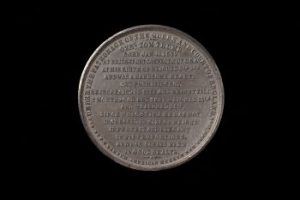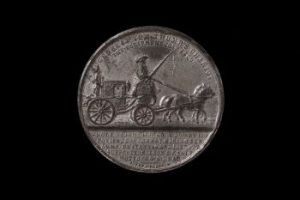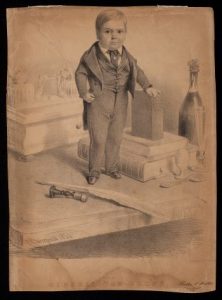Souvenir Medals, and a Snug Saloon to Draw and Read In
One of the things I’ve been doing as I read Barnum’s letters from France in his 1845-1846 copybook is to keep an eye out for clues and references to artifacts that are now in the Barnum Museum’s collection. So far, we’ve learned about the porcelain dinnerware and gilt-silver tea service that Barnum had purchased at an estate auction in Paris; Barnum’s first “conversations” concerning the creation of a guide book for the American Museum (our example is from 1849); and most recently, about Gen. Tom Thumb’s “little calling cards” of which there are several in the collection. This week, as we make a quick hop over to London while Barnum undertakes arrangements for the General’s return tour, we will learn about the English-made “medals” that were sold as souvenirs. You can see several examples of these medals, as well as smaller brass tokens, in the P. T. Barnum Digital Collection within the “Souvenirs and Toys” category. We’ll also gain some insights on Barnum’s relationship with Charles Stratton, the precocious young boy whom he mentored as “Gen. Tom Thumb,” and with whom he developed a lifelong friendship.
As we’ve learned from the July – October 1845 correspondence between Barnum and his business associates, the Tom Thumb tour through France had not lived up to his expectations of financial reward. The copybook letters begin after the entourage had left Paris, and Barnum’s references to the performances there tell us it was extremely successful: “The General has nearly killed the people in this part of the country, he has hit them so hard.” But as for venues in other parts of the country, well, not so much. Making arrangements at each town had its own particular challenges and frustrations, and the receipts did not amply compensate for all the difficulties, nor even cover the entourage’s expenses at times. Barnum was therefore anxious to finish up his tour obligations in France and return to England, certain that he could make up the losses and once again “pile up the tin.” With plans for the tour to close in Paris with performances of the play Le Petit Poucet running from mid-November to mid-December, Barnum took the opportunity in October to make a brief trip to London to start arranging things there.
One of his tasks was ordering more of the souvenir “medals” that had sold so successfully on the tour through the British Isles in 1844. They were designed and struck by Allen & Moore, a brand new firm in Birmingham, England, a city famous for manufacturing metal products. Though Barnum had brought medals to France to sell there too, he did not find a strong market, perhaps because the text on the medals was in English. Certain they would remain popular in England, he aimed to have a supply ready for the tour’s return in December, as well as order some to have on hand for Paris. Writing to “Messrs. [John] Allen & [Joseph] Moore” on October 23rd, 1845, Barnum informed them,
I am here for 2 or 3 days on a visit. General Tom Thumb is still in France but will be in England in December. I wish you to strike off 100 or 200 of my museum medals and send them immediately to my address at Long’s Hotel Bond Street London. If possible have them reach there as soon as saturday next (day after tomorrow) as I may be off on sunday. If you can get only 50 ready it will do just as well. Send also a few dozens of Tom Thumbs new medals with the 4 ponies—merely for specimens if you can do so conveniently—if not no matter.
He added that he expected to be in Birmingham in December and would pay for them then, also noting, “I think we have sufficient medals in France to last us till we arrive here—They dont sell in France as they do in England.” In a postscript he added, “Send them even if you dont get them ready till monday—but I prefer to have them saturday if possible, for fear I might go to France before monday.” (Barnum had written to his uncle that while in London he also planned to “pick up something new for my museum” which may explain his uncertain itinerary.)
The letter to Messrs. Allen and Moore, along with a little research into that company’s history, has shed light on the various “medals”—also referred to as tokens—in the collections of the Barnum Museum and the Bridgeport History Center at the Bridgeport Public Library. Between the two collections there are six of the medals of the type Barnum mentions, plus three smaller brass ones of a different type, featuring either Queen Victoria or Lady Liberty one side and Tom Thumb on the other. The six larger ones bear similarities to one another, but none are identical.
The three owned by the Barnum Museum are the earliest, having the date of 1844 and the firm name “Allen & Moore” on the obverse (front face). Among the three owned by the History Center, two that are similar to the Barnum’s bear only the name “J. Moore” on the obverse and have no date; the third must be from about 1864 or later as it features an image of Charles and his wife Lavinia with “their” (borrowed) baby and the birthdates of the three, the baby’s being December 5, 1863, ten months after the marriage. The J. Moore medals most likely date to the mid- or late 1850s when Moore was in business for himself, since the Allen & Moore partnership went bankrupt. The other clue to a post-1840s date is that Charles’s height is given as 31 inches, whereas the 1844 medals give his height as 25 inches. (Charles did grow—very slowly—over the course of his life, eventually reaching 42 inches.)

Though all the medals are worth taking a look at, here I will just provide links to the Barnum Museum’s since the three dated 1844 are relevant to Barnum’s letter, in which he mentions one with the American Museum and one with Gen. Tom Thumb’s coach and ponies. Barnum did not mention a third one in his letter, a medal featuring Charles’s biographical information on the reverse. My guess is that the two with texts on the reverse (Charles’s bio, and the description of the American Museum) were the first, or among the first, to be made. Possibly preceding those two was a medal with an image of the American Museum on the obverse and its description on the reverse (there is an example in a private collection).
I also suspect that when the General was gifted the handsome miniature equipage from the Queen, Barnum decided to have a new medal struck featuring the coach and ponies on the reverse, and this may have supplanted further orders for the biographical version. Also in a private collection, there is another version of the coach and ponies medal with Charles’ parents on the obverse in the distinctive overlapped profile style used for representing kings and queens on coinage!

With the exception of the “Mr. & Mrs. Stratton with baby” depiction, all the medals in the two Bridgeport collections show the same portrait of Charles Stratton on the obverse. The source for this image of him standing on a table next to several books is a print portrait by Charles Baugniet (1814-1886), a Belgian artist who worked in London and Paris and was noted for fine portraiture. In 1844, Baugniet drew lithograph portraits of both Barnum, seated at a writing desk, and Charles standing on a tabletop amidst a variety of objects that provide a sense of scale. Notably, the book standing upright on the stack beside Charles is titled Boyle’s Court Guide 1844, alluding to the necessary crash course on royal etiquette prior to meeting Queen Victoria. Even on the medals you can make out the book title!
Coming up for air after that deep dive with the medals, let’s take a look

at passages from Barnum’s letters concerning Charles. With this copybook we are witnessing the first few years of a relationship that lasted until Charles’s death in 1883. Of course when Barnum was penning these letters he had no idea how things would unfold nor for how long, and there are occasional hints that he worried about Charles’s health and longevity, and even that Charles’s popularity would fade. He often assured his correspondents that “the General” was “first rate,” a popular expression at the time that Charles himself seems to have favored. We have to bear in mind that sickness and death were more common daily worries for people before effective medical treatments existed, and from Barnum’s perspective, having lost one daughter to illness in 1844 and perpetually fearful that Helen, his five-year-old, might succumb to disease, his concern about Charles is completely understandable. Charles was, after all, only two years older than little Helen.

Notes of paternal fondness for the boy crop up in the letters. Twice so far Barnum has referred to him as “the coon,” and in closing a letter to Mr. Stratton from Lyon, he wrote, “Respects to all & especially the coon. He has got a snug saloon to draw and read in—adjoining the bedroom.” This passage brought to mind a page in the copybook that contains small drawings, which were almost certainly done by Charles. It was touching to learn that the 7 ½-year-old liked to draw and read, and that Barnum considered his comfort when booking hotel rooms at Lyon.
Given Barnum’s concern for Charles, I have pondered time and again how a young child could be expected to maintain the pace set for his various performances, and not suffer frequent meltdowns, or exhaustion and illness. A letter to “Friend Huet” in Paris, written while Barnum was on his short trip to London, gives us an example of the anticipated schedule when the entourage returned to Paris.
I wish you to offer the Salle Vivienne people 3000 francs for their saloon [for] one month night & day commencing the 19th of November or before. Perhaps we would like to commence by the 14th. If they will not accept that—please offer to arrange with [the] director of Vaudeville Theatre for one month—or 6 weeks or for 2 weeks if he prefers it—to play Petit-Poucet on the same terms as Mr Ancelot gave—1/3d recette brute [gross receipts], to play every night—consecutif. Tell the manager that he can announce that Genl Tom Pouce being about to depart for America, will pass through Paris and rest there for a limited number of nights only. Thousands of English are now visiting Paris and will be sure to go to see Petit-Poucet. If the manager accepts the offer, then you may engage Salle Vivienne for the same length of time at the rate of 1000 francs per month for the day time only.
Two performances a day, seven days a week is a lot for anyone, let alone a child. How taxing this was on Charles is hard to say, though he seems to have had good spirit and stamina.
In a postscript, Barnum presented Huet with other options to pursue in case none of the aforementioned worked out. He also commented, “Salle Vivienne is doubtless the best, as the public [knows that] was where he appeared before.” And, we, who already know that Barnum was planning to spend most of 1846 in the British Isles, can chuckle at his sly remark about Genl Tom Pouce soon returning to America. With “thousands of English” visiting Paris at the time, Barnum clearly aimed to hook these potential theatre-goers with his lure, as they might not bother to see Tom Thumb in Paris if they knew the truth, that they could see him later on in London. As always, Barnum was determined to be successful and left no promotional tactic or income-generating opportunity unturned!
Adrienne Saint-Pierre
Barnum Museum Curator

